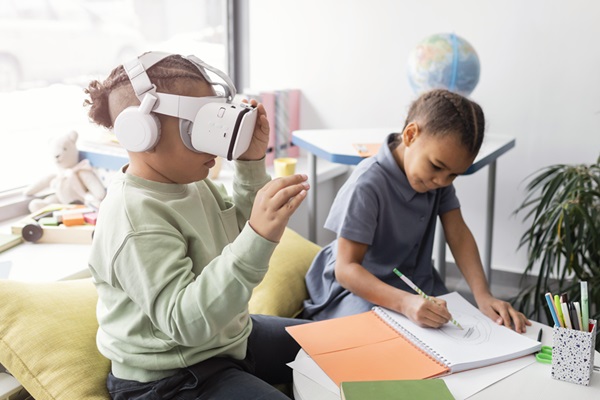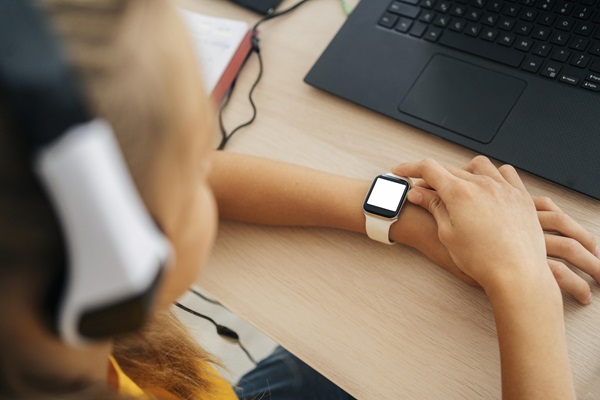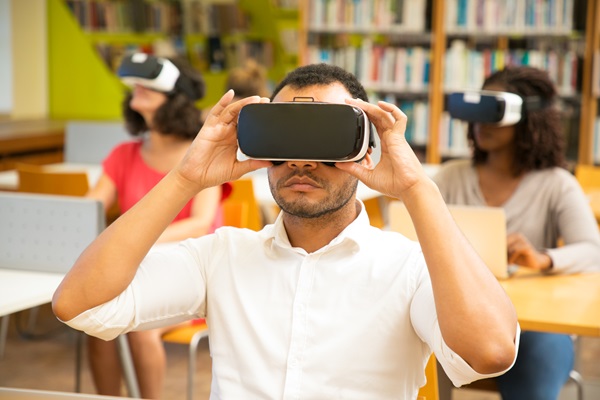Wearable technology in education refers to the use of smart devices worn by students and educators to enhance learning and classroom experiences. These devices, including smartwatches, AR glasses, fitness trackers, and VR headsets, offer interactive and data-driven tools that support personalized learning, improve student engagement, and provide valuable insights into academic and health metrics. As technology evolves, wearable devices are becoming integral in modern education, transforming traditional teaching methods and fostering innovative learning environments.

I. Introduction
A. Overview of Wearable Technology and Its Growth
Wearable technology has seen explosive growth over the past decade, evolving from simple fitness trackers to sophisticated smart devices capable of transforming various sectors, including education. Wearable technology in education is a burgeoning field that integrates smart devices into the learning environment to enhance educational outcomes and engagement.
B. Importance of Technological Integration in Education
The integration of technology in education is no longer a luxury but a necessity. It facilitates more engaging and interactive learning experiences, supports diverse learning styles, and provides educators with tools to better understand and address students’ needs. Wearable technology in education represents a significant advancement in this trend, offering unique opportunities to revolutionize traditional teaching methods.
C. Objectives of the Article: Exploring the Role of Wearables in Empowering Learning
This article aims to explore how wearable technology in education is empowering learning through smart devices. We will delve into the types of wearables used in classrooms, their benefits, and how they enhance student engagement, personalized learning, collaboration, and health.
II. Understanding Wearable Technology in Education
A. Definition and Types of Wearable Devices Used in Education
Wearable technology in education encompasses a range of devices designed to be worn by students and teachers to support various educational activities. These include:
- Smartwatches and Fitness Trackers: Monitor physical activity and health metrics.
- Augmented Reality (AR) Glasses: Provide immersive and interactive learning experiences.
- Smart Clothing and Biosensors: Track physiological data and student engagement.
- Virtual Reality (VR) Headsets: Offer immersive virtual learning environments.
B. The Growing Trend of Smart Devices in Classrooms and Learning Environments
The adoption of wearable technology in education is on the rise, driven by the need for innovative teaching tools and the desire to enhance the learning experience. Schools and educational institutions are increasingly incorporating smart devices into their curriculums to provide interactive, data-driven, and personalized educational experiences.
C. Benefits of Wearable Tech for Students and Educators
Wearable technology in education offers numerous benefits, including:
- Enhanced Learning Experiences: Interactive and immersive learning tools can make lessons more engaging.
- Personalized Learning: Wearables can adapt to individual learning styles and needs.
- Improved Health and Well-being: Devices that monitor physical and mental health can help manage student well-being.
- Efficient Data Collection: Real-time data collection provides valuable student performance and engagement insights.
III. Key Wearable Devices for Educational Use
A. Smartwatches and Fitness Trackers: Promoting Health and Time Management in Schools
Smartwatches and fitness trackers are increasingly used in schools to promote health and time management. These devices help students track their physical activity, set fitness goals, and manage their time effectively. Educators can use data from these devices to monitor students’ physical activity levels and ensure they maintain a healthy balance between study and physical exercise.
B. Augmented Reality (AR) Glasses: Enhancing Interactive Learning Experiences
AR glasses provide students with immersive and interactive learning experiences by overlaying digital information onto the physical world. These devices enable students to interact with educational content more engagingly, such as visualizing complex scientific concepts or exploring historical events in a virtual environment.
C. Smart Clothing and Biosensors: Monitoring Student Well-being and Engagement
Smart clothing and biosensors are equipped with technology that monitors students’ physiological data, such as heart rate, body temperature, and stress levels. This data can provide insights into students’ well-being and engagement, helping educators tailor their approach to meet individual needs and ensure a positive learning environment.
D. VR Headsets: Immersive Learning in Virtual Classrooms
VR headsets offer students the ability to experience immersive virtual environments, which can enhance learning in subjects such as history, science, and geography. By providing virtual field trips or simulations, VR headsets can make learning more engaging and memorable.

IV. Enhancing Student Engagement and Learning Outcomes
A. How Wearable Tech Increases Student Participation
Wearable technology in education can significantly increase student participation by making learning more interactive and engaging. For example, AR glasses and VR headsets can transform traditional lessons into immersive experiences, while smartwatches can gamify learning through fitness challenges or educational apps.
B. Real-time Feedback and Assessment Through Smart Devices
Smart devices enable real-time feedback and assessment, allowing educators to track student progress and adjust their teaching strategies accordingly. Wearables can provide instant data on student performance, enabling teachers to identify areas where students may need additional support.
C. Case Studies: Success Stories of Wearable Tech Implementation in Education
Numerous schools and educational institutions have successfully implemented wearable technology to enhance learning outcomes. For instance, some schools have used VR headsets to conduct virtual field trips, while others have employed fitness trackers to promote physical activity among students. These case studies demonstrate the potential of wearable technology to transform education.
V. Personalized Learning Through Wearable Technology
A. Adapting Curriculum to Individual Learning Styles with Wearables
Wearable technology in education allows for personalized learning by adapting the curriculum to individual student’s needs and learning styles. For example, smart devices can track students’ progress and preferences, enabling educators to tailor lessons and resources to better support each student’s unique learning journey.
B. Monitoring Student Progress and Providing Tailored Support
Wearables provide valuable data that educators can use to monitor student progress and provide tailored support. By analyzing data from smart devices, teachers can identify trends and adjust their teaching methods to better address students’ strengths and weaknesses.
C. Examples of Personalization Using Wearables in the Classroom
Examples of personalization using wearables in the classroom include adaptive learning platforms that use data from smart devices to customize educational content, or fitness trackers that help students set and achieve personal health goals. These applications demonstrate how wearable technology can enhance individualized learning experiences.
VI. Improving Collaboration and Communication
A. Wearables Facilitating Communication Between Students and Teachers
Wearable technology can improve communication between students and teachers by providing tools for instant messaging, notifications, and updates. Smartwatches, for instance, can enable students to communicate with their teachers quickly and easily, fostering a more connected and responsive learning environment.
B. Collaborative Projects Enhanced by Smart Devices
Smart devices can enhance collaborative projects by providing tools for real-time collaboration, data sharing, and group work. For example, AR glasses and VR headsets can facilitate collaborative virtual projects, allowing students to work together on interactive assignments and simulations.
C. Virtual Field Trips and Group Learning Experiences Using Wearable Tech
Wearable technology enables virtual field trips and group learning experiences by providing immersive and interactive environments for students to explore. VR headsets, for instance, can transport students to historical sites, scientific labs, or distant planets, offering a unique and engaging way to learn.

VII. Health and Safety Applications in Education
A. Monitoring Physical and Mental Health with Wearables
Wearable technology in education plays a crucial role in monitoring students’ physical and mental health. Devices such as fitness trackers and biosensors can track various health metrics, helping educators and parents identify potential issues and provide timely support.
B. Addressing Student Safety Through GPS Tracking and Alert Systems
Wearable devices equipped with GPS tracking and alert systems can enhance student safety by providing real-time location data and emergency alerts. These features are particularly valuable for monitoring students’ whereabouts during field trips or outdoor activities.
C. Implementing Wellness Programs in Schools with Wearable Data
Schools can use data from wearable devices to implement wellness programs that promote healthy habits and overall well-being. For example, fitness trackers can be used to encourage physical activity and healthy lifestyle choices among students.
VIII. Challenges and Considerations
A. Privacy and Data Security Concerns in Educational Wearables
The use of wearable technology in education raises concerns about privacy and data security. Schools must ensure that student data is protected and that wearable devices comply with relevant privacy regulations to safeguard sensitive information.
B. Costs and Accessibility Issues for Schools and Students
The cost of wearable technology can be a barrier to widespread adoption in schools. Ensuring that devices are affordable and accessible to all students is crucial for maximizing the benefits of wearable technology in education.
C. Addressing Teacher Training and Integration Hurdles
Effective integration of wearable technology in education requires adequate teacher training and support. Educators must be equipped with the skills and knowledge to use smart devices effectively and integrate them into their teaching practices.
IX. Future Trends in Wearable Technology in Education
A. The Potential of AI-powered Wearable Devices in Personalized Learning
The future of wearable technology in education may include AI-powered devices that offer even greater levels of personalization and adaptive learning. AI can analyze data from wearables to provide customized learning experiences and support.
B. Emerging Innovations in AR and VR for Educational Purposes
Advancements in AR and VR technology will continue to shape the future of education, providing new opportunities for immersive and interactive learning experiences. Innovations in these areas may lead to more engaging and effective educational tools.
C. Predictions for the Next Generation of Wearables in Schools
The next generation of wearable technology in education is likely to include more advanced and integrated devices, offering enhanced features and capabilities. Predictions for future wearables include increased connectivity, improved data analytics, and more seamless integration with educational platforms.
X. Conclusion
A. Recap of the Impact of Wearable Technology on Education
Wearable technology in education has the potential to significantly impact learning by providing innovative tools for engagement, personalization, and assessment. From smartwatches to VR headsets, these devices are transforming how students and educators interact with educational content.
B. Strategic Recommendations for Schools Adopting Wearable Tech
Schools considering the adoption of wearable technology should focus on selecting devices that align with their educational goals, ensuring data privacy and security, and providing adequate training for educators. Strategic implementation can maximize the benefits of wearables and enhance the learning experience.
C. Final Thoughts on the Future of Learning Empowered by Smart Devices
The future of education is increasingly intertwined with wearable technology, offering new opportunities for smarter, more personalized, and engaging learning experiences. As technology evolves, schools and educators must embrace these innovations to empower the next generation of learners.

